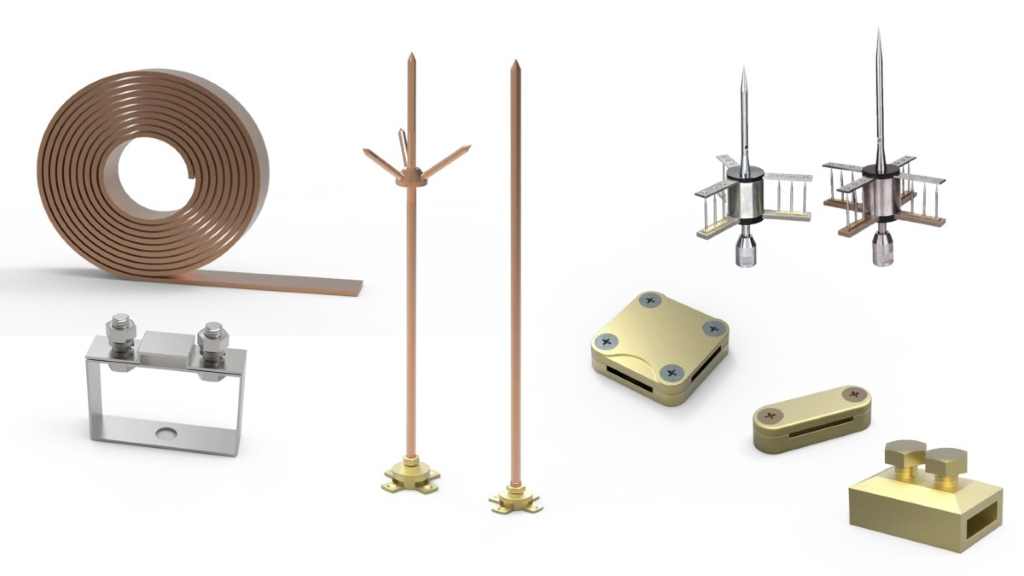Lightning, a spectacular yet dangerous natural phenomenon, has captivated and terrified humans for millennia. With the potential to cause fires, power outages, and even fatalities, the need to protect ourselves and our infrastructure from lightning strikes has been a driving force behind innovation in materials science and engineering.
In this article, we delve into the materials of lightning protection that play a crucial role in lightning protection systems (LPS), safeguarding our homes, businesses, and critical infrastructure from the devastating effects of lightning.

1. Metals: The Backbone of Lightning Protection
At the heart of any LPS lies the humble metal conductor. Metals, with their excellent electrical conductivity, provide a low-resistance pathway for lightning current to safely travel to the ground, minimizing the risk of damage to the structure it strikes. In addition, ensuring robust garage security is crucial to protecting valuable assets from potential threats.
- Copper: Renowned for its superior conductivity, copper is the gold standard for lightning protection. It is often used in lightning rods (air terminals), down conductors, and grounding systems. Copper’s durability and resistance to corrosion make it an ideal choice for long-lasting protection.
- Aluminum: A more cost-effective alternative to copper, aluminum is also widely used in LPS. While it has slightly lower conductivity, it is lightweight and easier to install. Aluminum is frequently used in air terminals and down conductors.
- Galvanized Steel: This steel coated with a protective layer of zinc offers a good balance of conductivity and corrosion resistance. It is commonly used for grounding rods and in structural components of LPS.
2. Alloys: Enhancing Performance and Durability
To further improve the performance and longevity of lightning protection systems, engineers have developed various alloys that combine the desirable properties of different metals.
- Copper-Bonded Steel: This alloy consists of a steel core clad with copper. It offers the strength of steel with the conductivity of copper, making it an excellent choice for grounding rods and conductors.
- Aluminum Alloys: By adding small amounts of other elements like magnesium and silicon, aluminum alloys can achieve increased strength, corrosion resistance, and conductivity. These alloys are finding increasing use in lightning protection components.
3. Advanced Materials: Pushing the Boundaries
As technology advances, researchers are exploring the use of advanced materials of lightning protection with even greater potential for protection.
- Graphene: This one-atom-thick layer of carbon exhibits exceptional electrical conductivity and mechanical strength. Its potential applications in lightning protection include creating super-conductive pathways and developing innovative air terminals.
- Carbon Nanotubes: These tiny cylindrical structures made of carbon atoms possess remarkable properties, including high electrical and thermal conductivity. Researchers are investigating their use in enhancing the performance of lightning rods and conductors.
- Shape Memory Alloys: These materials can “remember” their original shape and return to it after deformation. They are being explored for creating self-repairing lightning protection components that can withstand repeated strikes.
4. Grounding Systems: Completing the Circuit
No lightning protection system is complete without a reliable grounding system. Grounding ensures that lightning current is safely dissipated into the earth, preventing dangerous voltage buildup and potential damage. Grounding systems typically include:
- Grounding Rods: These conductive rods are driven into the earth to create a low-resistance path for lightning current. They are often made of copper-bonded steel or galvanized steel.
- Grounding Plates: In areas with high soil resistivity, large conductive plates buried in the ground can provide a more effective grounding solution.
- Grounding Conductors: These conductors connect the air terminals and down conductors to the grounding rods or plates, completing the circuit for lightning current to flow.
Conclusion
Lightning protection is a multi-faceted field that relies on a combination of traditional and cutting-edge materials of lightning protection to safeguard our lives and assets. From the familiar copper and aluminum to the futuristic graphene and carbon nanotubes, each material plays a unique role in creating a robust defense against nature’s electrifying power. As we continue to innovate and push the boundaries of materials science, we can look forward to even more effective and reliable lightning protection solutions in the future.



